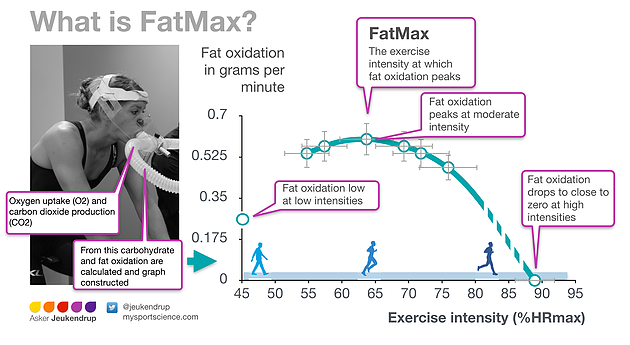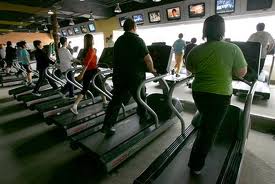Are you ready to get the most out of your body and take your performance to the next level?
Are you ready to start training SMARTER?
Metabolic Exercise Test: $150
Resting Metabolic Test (RMR): $100
Includes Report: SAMPLE REPORT
Exercise and Resting Metabolic Test Combo: $225
Follow up re-testing to determine training progress:
Exercise: $60.00
Resting: $50.00
Combo Resting and Exercise: $100

Are You Ready To Use SCIENCE To Reach Your Goals?
Find out where and at what heart rates your body burns fats, proteins and carbohydrates.
How many calories you need to lose weight, gain muscle mass or improve your sport performance.
How many calories of fats, proteins and carbohydrates you should be taking in to meet your goals.
What types of exercises and how often you should be exercising to meet your specific goals.
FatMax Metabolic Testing
(From http://www.mysportscience.com) Fat burning or fat oxidation (the term preferred by scientists) is of interest to endurance athletes and other athletes. Non-athletes who want to reduce body weight or body fat have also been interested in the topic. When I started to study fat burning during exercise in the 1990s, I was interested in nutrients that could stimulate fat oxidation or at least allow fat oxidation to occur. It was common practice in research projects to study the effects of an intervention on fat oxidation at one fixed exercise intensity. For example, studies had investigated the effects of caffeine on fat oxidation during exercise. Athletes exercised twice at 70% of their maximum. Once with caffeine and once with placebo.
The problem with this approach is that you can only draw conclusions about what caffeine does to fat burning at that particular intensity. You still don’t know what happens at lower and at higher intensities. If you want to know the answers to these questions as well, you would have to conduct completely separate experiments. This is expensive and time consuming.
Therefore we developed a test that would give information about fat oxidation at a wide range of intensities (instead of just one intensity). This test was called the FatMax test (because the test can be used to determine the individuals exercise intensity at which fat burning is “maximal”).
The FatMax test lasts about 20-45 min, depending mostly on how trained the athlete is. The test starts at a low intensity (equivalent to walking) and every 3 min the intensity is increased (power on a bike or speed on a treadmill). During the test, expired gases are collected and/or measured from the athlete. This is used to calculate fat burning as well as carbohydrate burning.
How does this work? When fat and carbohydrate are oxidized, different amounts of oxygen (O2) are used and different amounts of carbon dioxide (CO2) are produced. The ratio of the expired volume of CO2 to O2 therefore tells you something about the fuel that is being used. If, for example, only carbohydrate is used, this ratio of CO2:O2 is 1:1. If only fat is used as a fuel this ratio is 0.7:1. Scientists express this in a so called respiratory exchange ratio or RER. RER ranges from 0.7-1.0 but is usually somewhere in between, indicating that a mixture of carbohydrate and fat is used.
This method can give us pretty accurate figures for carbohydrate and fat use, although we do make a number of assumptions and scientists must be careful not to violate those! One such assumption is that all CO2 produced and O2 used is derived from the oxidation of either fat or carbohydrate. This is a reasonable assumption in most cases. However, when the intensity is high; when breathing becomes difficult and talking would be an effort; lactic acid is being formed and when this happens the acid will be buffered by a buffer that the body naturally contains: bicarbonate. As soon as this starts to happen bicarbonate will release CO2 and water. Thus we have another source of CO2, that is not directly related to carbohydrate and fat oxidation. In short, the method of calculating carbohydrate and fat burning cannot be used at high intensities.
So if we use this technique during a FatMax test we can plot carbohydrate and fat oxidation against exercise intensity. Carbohydrate oxidation increases linearly with exercise intensity. Fat oxidation shows a different pattern, the so called FatMax. In this figure you can see that on average (the data displayed is averaged from a larger group of athletes), fat oxidation increases as the exercise intensity increases from walking to jogging or running at a moderate pace. Then, when the intensity increases from running at a moderate pace to running fast, fat oxidation actually drops. Fat burning peaks at a moderate intensity. This intensity is what we call FatMax.
Fat burning is highly individual. These findings cannot be applied to every athlete.
There is no one fat burning zone for all athletes
Fat oxidation is lower at higher intensities in ALL athletes, independent of their diets or other factors that may influence fat burning
People have asked me why do we need a FatMax test? There are a number of reasons. First it was designed as a research tool and this tool will help us to understand better how fat oxidation responds to a variety of interventions. Can we use Fatmax to guide our training? Probably. It gives you similar information to what a lactate curve will give you. But of course whether you base your training on lactate measurements, fatmax or any other parameter, it does not mean that training at one intensity is necessarily better than training at another intensity. In order to improve a range of training stimuli is needed. One of the most useful practical applications of the FatMax test is as a tool to see how much progress is made over a period of weeks.
I should also point out that measuring FatMax well is not easy and there are few labs that can do this with the accuracy that is required. I have seen many bogus results and results that have been printed without critically analyzing them first.
References
Achten J, Jeukendrup AE. Fatmax: A New Concept to Optimize Fat Oxidation During Exercise? Eur J of Sport Sci 2001; 1(5): 1-5.
Achten J, Gleeson M, Jeukendrup AE. Determination of the exercise intensity that elicits maximal fat oxidation. Med Sci Sports Exerc. 2002; 34(1):92-7.
Venables MC, Achten J, Jeukendrup AE. Determinants of fat oxidation during exercise in healthy men and women: a cross-sectional study.
J Appl Physiol 2005; 98(1):160-7.

Are you exercising and still not losing weight, even with a good diet?
If so, you are likely working out in the wrong heart rate zone can causing your body to burn sugar as fuel and NOT fat. A Metabolic VO2 Max Testing can tell you where your heart rate needs to be to teach your body to burn more fat.
Through Metabolic VO2 testing we can decide what you are burning as fuel (Fats, Carbohydrates, or Proteins) at various heart rates and exercise intensities. We can then develop nutrition and training concepts that will improve the body’s ability to burn fat.
480-633-6837
drjbanas@gmail.com

About the Metabolic VO 2 Efficiency Test
How do you decide where you are metabolic efficient (the heart rates where are you burning the highest percent of fat?
We test you on your bike or on a treadmill. You wear a mask the collects the air that you breath out. The ratio of the volume of carbon dioxide released to the volume of oxygen consumed, called the respiratory exchange ratio (RER), also sometimes known as the respiratory quotient (RQ).
NOTE: Formulas to decide heart rate are very unreliable
Go here for more info on More info on VO2 Max Testing